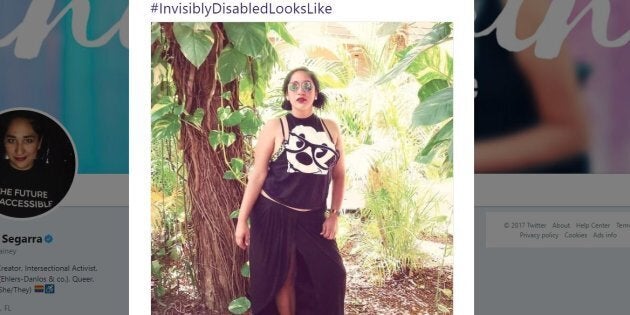
Disabilities aren't just physical, and Twitter is here to prove it.
In the past two days, thousands of people have shared what their invisible disability looks like to change society's perception that disabilities can only be seen.
An invisible disability refers to a limitation — whether it mental, sensory, neurological or physical — that is hidden. This includes hearing loss, learning disabilities, mental disorders (such as anxiety), and physical disorders (such as fibromyalgia).
These disabilities can be challenging to live with and can cause physical and mental pain. As one Twitter user pointed out, "If invisible illnesses were visible, this is what it would like..."
That's why Florida activist Annie Segarra started the hashtag #InvisiblyDisabledLooksLike, asking people to share photos of their hidden limitations to cap off Invisible Disabilities Week, which ended on Oct. 21.
To kick things off, she shared a photo of herself, alongside a list of her own limitations.
Segarra's tweet received an overwhelming response. BBC News reports that the hashtag has now been used over 3,000 times as of Wednesday morning.
Some also revealed how it feels when people don't recognize their invisible disabilities.
According to the World Health Organization, over a billion people around the world have some form of disability. In Canada, 3.8 million adults identified as having some kind of limitation in 2012.
While there's no Canadian data on the extent of invisible disabilities across the country, the Learning Disability Association of Canada reports that one in 10 Canadians has a learning disability.
According to the World Health Organization, over a billion people around the world have some form of disability.
Despite the large number of people who have a disability (both visible and invisible), there is still a stigma around them. That's why plenty of campaigns have tried to raise awareness.
Earlier this month, for instance, Toronto activist Kate Welsh created pins for people with invisible disabilities to wear as a way to politely let others know that they may be in need of a seat.
And in September, Holland Bloorview, a kids' rehabilitation hospital in Toronto, launched a campaign called "Dear Everybody" to correct people's assumptions that children with disabilities are less than.
"We live with our disabilities every day. You might think that's the biggest problem but it isn't," their open letter read. "The biggest problem is the world that's full of stigma around living with a disability."
Also on HuffPost: